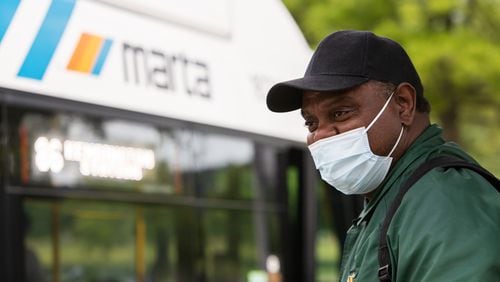A year after suspending most of its routes amid the coronavirus pandemic, MARTA will resume normal bus operations Saturday — a move that will have a big impact on thousands of metro Atlanta residents.
The regional transit agency suspended 70 of its 110 routes last April and boosted service on most of the remaining routes. The idea was to provide more buses on busy routes to allow passengers to spread out — a “social distance” strategy designed to prevent the spread of COVID-19.
Now MARTA says it has installed new air filters and other equipment that will keep passengers safe. Though there will be limits on the number of passengers on each bus, the agency says it can now safely resume service that is a lifeline for thousands of people.
“Our customers will be safe and can sit next to each other again,” Deputy General Manager Collie Greenwood said.
But the yearlong suspension of bus service has taken a toll on many people who depend on transit to get around. DeKalb County resident Albert Rogers is legally blind and resorted to expensive ride-hailing services to get to work early in the pandemic. Fortunately, his employer allowed him to work from home.
“If it had not been for my reasonable accommodation request I may have very well quit,” Rogers said.
The suspension of bus service was just one of the ways MARTA responded to the pandemic. Last spring it stopped collecting bus fares to limit contact between passengers and drivers, although fares returned in September. It stepped up the cleaning of buses, trains and stations.
It bought protective equipment and provided hazard pay for employees. And it required passengers to wear masks and distributed them for free.
But nothing disrupted the lives of passengers like the suspension of bus service. MARTA focused the remaining service on its busiest routes and on those that served hospitals, major employment centers and other essential destinations. It ran buses more frequently in those areas.
The move benefited many passengers. Tejas Kotak of Atlanta said his usual routes became more reliable during the pandemic because of better traffic and more frequent service. He said he’ll have to plan for longer wait times with the return of regular service.
“I’ll have the ability to go more places with all the routes back, and more options to get to my usual stores and destinations,” Kotak said. “I will have to plan more time in my travel schedule to deal with waits during bus-to-bus transfers.”
Others said the loss of service was devastating. Keith Arendall of Atlanta said he quit his job downtown because he could no longer afford to get there. His regular bus route was eliminated, and he used taxi and ride-hailing services to get to MARTA’s Hamilton E. Holmes station. He was spending about $140 a week on fares.
“I was working for nothing,” Arendall said.
The suspension of service sparked protests and an unsuccessful lawsuit, which is under appeal. It also generated an unsuccessful complaint to the Federal Transit Administration, which said MARTA had the authority to make the emergency service changes because they did not last more than a year.
Greenwood said it was new safety equipment and improving pandemic conditions that ultimately led MARTA to restore service.
The agency has installed anti-microbial air filters on its buses. It also has installed “bipolar ionization” cleaning equipment that provides fresh air every 75 seconds.
That equipment, the other precautions and changing conditions — including the availability vaccines — have made it safe to restore service, Greenwood said.
There will be limits. A federal mask mandate for transit passengers remains in effect.
And MARTA will not permit buses to get so full that passengers must stand. When every seat is taken, drivers won’t accept more passengers. Greenwood said MARTA will dispatch another vehicle to pick up passengers who can’t board a full bus.
MARTA also hasn’t decided whether to keep the new circulator route on Oakley Industrial Boulevard that it launched during the pandemic to serve key destinations such as Clorox, Duracell and U.S. Food. Ridership on the route after regular service resumes will determine whether the circulator is discontinued.
Greenwood said the suspension of service was rough on many customers. But he believes the steps taken during the coronavirus pandemic could prevent a similar suspension in the future.
“Should there be a next time,” he said, “our system is far more resilient today than it was a year ago.”







